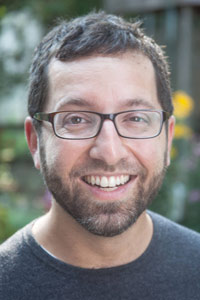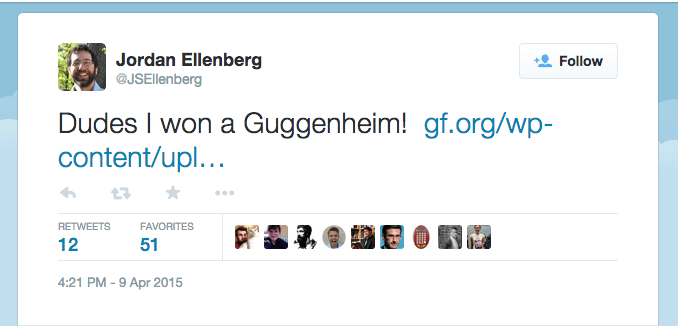Numbers may not always tell the whole story, but they tell an interesting one when the storyteller is Jordan Ellenberg, the John D. MacArthur and Vilas Distinguished Achievement Professor of Mathematics at the University of Wisconsin-Madison and a Discovery Fellow at the Wisconsin Institute for Discovery (WID).

Ellenberg was awarded a Guggenheim Fellowship this year by the John Simon Guggenheim Memorial Foundation. 173 Fellowships, selected from over 3100 applications in 2015, were awarded to “advanced professionals in mid-career…who have demonstrated exceptional capacity for productive scholarship or exceptional creative ability in the arts.”
We talked with Ellenberg about his deep and abiding love for mathematics, how math is inextricably and intricately connected with our lives, what it means to be a Guggenheim Fellow, and what he intends to use the award for.
“Most of the [Guggenheim] awards go to artists and writers,” says Ellenberg, who tweeted “Dudes, I won a Guggenheim!” when he first learned of the award. “But working at a university that values the liberal arts, like UW-Madison, it’s important to me that all the different, but related, parts of the intellectual enterprise – such as mathematics – are recognized.”
Ellenberg’s interest in math goes as far back as he can remember. “I have always liked mathematics, ever since I was a little kid,” he says. “Different life stories lead one to mathematics; mine was simply that when I was little I was excited about math, wanted to do it, and when I did things other than math I found I missed it and wanted to get back to it.”
To Ellenberg math is one of the basic ways human beings have tried to make sense the world around them. He is the author of the New York Times bestseller “How Not to be Wrong”, where he shows how mathematics is a part of our everyday lives. “In every civilization, every culture, all through history people have been thinking mathematically about the problems they have faced, whether they set that up formally or not, whether they think of themselves as mathematicians or not,” he says.
“When I did things other than math I found I missed it and wanted to get back to it.”
-Jordan Ellenberg
While the love for all things math was always present, pursuing interdisciplinary research wasn’t always on the agenda for Ellenberg. “At the beginning of my career I was up in the math building and I thought ‘I am never going outside!’” he says. “I didn’t really understand just how much amazing stuff was going on out there that overlapped with my interests.”
But over his career Ellenberg has come to appreciate the interdisciplinary nature of mathematics, its capacity to transcend the boundaries between different academic fields and connect them. In fact, he intends to use the Guggenheim Fellowship to pursue this interest in research at the interface of various academic disciplines. “I started out as a number theorist; that’s what I was trained as and what I have done for most of my career,” he says. “What I am working on now is really trying to connect that area and other more geometric areas.”
Being a Discovery Fellow at WID gives Ellenberg the opportunity to work with researchers from several different fields. “The WID is an amazing engine, not just for encouraging collaborations between the sciences but also because there are people like Lynda Barry – the renowned cartoonist – here, who was a culture hero of mine as a kid,” he says. In fact, it was Barry who convinced Ellenberg to draw figures and write out equations for his book “How Not to be Wrong” by hand.
“It’s an incredibly exciting interdisciplinary group here [at WID], which is working at the interfaces between computer science and engineering and areas of math,” says Ellenberg. “I am trying to bring a geometric perspective into that area, and winning this Fellowship will allow me to devote more of my efforts to building those bridges with this side of campus.”
 David Krakauer, the director of the Wisconsin Institute for Discovery, is equally happy to have Ellenberg as a Discovery Fellow. “I know many gifted mathematicians, several science writers, and a few big thinkers who are able to connect deep and often difficult ideas to everyday life,” says Krakauer. “Jordan pulls off all three and I think that the Guggenheim Fellowship reflects this rare accomplishment. It has been a real pleasure having Jordan as a Discovery Fellow in the WID — in many ways he represents core values and ideas that we have been cultivating in the Institute: exploratory, rigorous, connected, and communicative.”
David Krakauer, the director of the Wisconsin Institute for Discovery, is equally happy to have Ellenberg as a Discovery Fellow. “I know many gifted mathematicians, several science writers, and a few big thinkers who are able to connect deep and often difficult ideas to everyday life,” says Krakauer. “Jordan pulls off all three and I think that the Guggenheim Fellowship reflects this rare accomplishment. It has been a real pleasure having Jordan as a Discovery Fellow in the WID — in many ways he represents core values and ideas that we have been cultivating in the Institute: exploratory, rigorous, connected, and communicative.”
One of the questions Ellenberg is trying to answer is what we mean when we say that a computational problem is hard. “I know that sounds kind of obvious, but there’s a whole taxonomy of difficulty,” he says, “and one of the challenges we face is understanding how to tell the difference between a problem that’s going to be computationally difficult and one that’s going to be computationally possible. That’s a very interesting mix of traditional computer science and statistics and, in my case, a certain amount of geometry as well.”
Ellenberg says he tries to reveal the mathematical structures in everyday life with which people are already engaged. But he accepts that engaging in mathematics research may not be everyone’s cup of tea. “I don’t long for a world where everyone is as drawn to math as I am” he says. “That would be weird, and we don’t need that many professional mathematicians!”
-Adityarup Chakravorty


You must be logged in to post a comment.